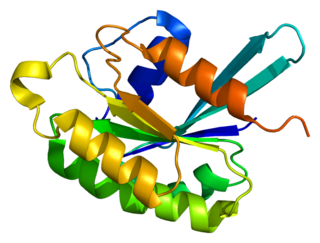Bicaudal D cargo adaptor 1 is a protein that in humans is encoded by the BICD1 gene. [5] [6]
Bicaudal D cargo adaptor 1 is a protein that in humans is encoded by the BICD1 gene. [5] [6]
This gene is one of two human homologs of Drosophila bicaudal-D. It has been implicated in COPI-independent membrane transport from the Golgi apparatus to the endoplasmic reticulum. Two alternative splice variants have been described. Other alternative splice variants that encode different protein isoforms have been described but their full-length nature has not been determined. [6]

Dynactin subunit 1 is a protein that in humans is encoded by the DCTN1 gene.

Ras-related protein Rab-6A is a protein that in humans is encoded by the RAB6A gene located in the eleventh chromosome. Its main function is the regulation of protein transport from the Golgi complex to the endoplasmic reticulum and the exocytosis along with the microtubules.

Golgin subfamily A member 2, also known as 130 kDa cis-Golgi matrix protein 1 (GM130) is a protein that in humans is encoded by the GOLGA2 gene.

Dynactin is a 23 subunit protein complex that acts as a co-factor for the microtubule motor cytoplasmic dynein-1. It is built around a short filament of actin related protein-1 (Arp1).

General vesicular transport factor p115 is a protein that in humans is encoded by the USO1 gene.

CAP-GLY domain containing linker protein 1, also known as CLIP1, is a protein which in humans is encoded by the CLIP1 gene.

Dynactin subunit 2 is a protein that in humans is encoded by the DCTN2 gene

Alpha-centractin (yeast) or ARP1 is a protein that in humans is encoded by the ACTR1A gene.

ADP-ribosylation factor GTPase-activating protein 1 is an enzyme that in humans is encoded by the ARFGAP1 gene. Two transcript variants encoding different isoforms have been found for this gene.

Golgi reassembly-stacking protein 1 (GORASP1) also known as Golgi reassembly-stacking protein of 65 kDa (GRASP65) is a protein that in humans is encoded by the GORASP1 gene.

Transmembrane emp24 domain-containing protein 10 is a protein that in humans is encoded by the TMED10 gene.

Ras-related protein Rab-2A is a protein that in humans is encoded by the RAB2A gene.

Centromere/kinetochore protein zw10 homolog is a protein that in humans is encoded by the ZW10 gene. This gene encodes a protein that is one of many involved in mechanisms to ensure proper chromosome segregation during cell division. The encoded protein binds to centromeres during the prophase, metaphase, and early anaphase cell division stages and to kinetochore microtubules during metaphase.

Bicaudal D cargo adaptor 2 is a protein that in humans is encoded by the BICD2 gene.

CAP-Gly domain-containing linker protein 2 is a protein that in humans is encoded by the CLIP2 gene.

Transmembrane emp24 domain-containing protein 2 is a protein that in humans is encoded by the TMED2 gene.

Golgin subfamily A member 1 is a protein that in humans is encoded by the GOLGA1 gene.

Ras-related protein Rab-6B is a protein that in humans is encoded by the RAB6B gene.

Anna Sergeevna Akhmanova is a Russian-born professor of Cell Biology at Utrecht University in the Netherlands. She is best known for her research regarding microtubules and the proteins, called TIPs, that stabilize one specific end of the tubules. Among the awards she has won, she was one of the recipients of the 2018 Spinoza Prize, the highest honor for Dutch scientists.

Giantin or Golgin subfamily B member 1 is a protein that in humans is encoded by the GOLGB1 gene. Giantin is located at the cis-medial rims of the Golgi apparatus and is part of the Golgi matrix that is responsible for membrane trafficking in secretory pathway of proteins. This function is key for proper localisation of proteins at the plasma membrane and outside the cell which is important for cell function that is dependent on for example receptors and the extracellular matrix function. Recent animal model knockout studies of GOLGB1 in mice, rat, and zebrafish have shown that phenotypes are different between species ranging from mild to severe craniofacial defects in the rodent models to just minor size defects in zebrafish. However, in adult zebrafish a tumoral calcinosis-like phenotype was observed, and in humans such phenotype has been linked to defective glycosyltransferase function.